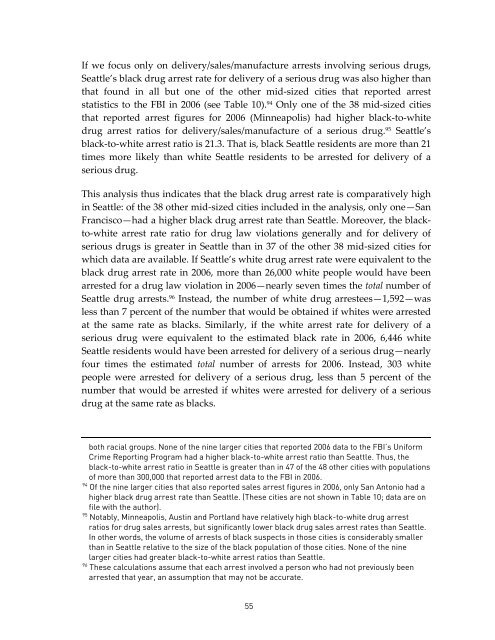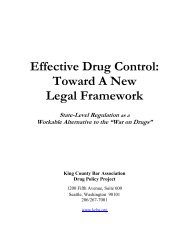RACE AND THE ENFORCEMENT OF DRUG DELIVERY LAWS IN ...
RACE AND THE ENFORCEMENT OF DRUG DELIVERY LAWS IN ...
RACE AND THE ENFORCEMENT OF DRUG DELIVERY LAWS IN ...
Create successful ePaper yourself
Turn your PDF publications into a flip-book with our unique Google optimized e-Paper software.
If we focus only on delivery/sales/manufacture arrests involving serious drugs,<br />
Seattle’s black drug arrest rate for delivery of a serious drug was also higher than<br />
that found in all but one of the other mid-sized cities that reported arrest<br />
statistics to the FBI in 2006 (see Table 10). 94 Only one of the 38 mid-sized cities<br />
that reported arrest figures for 2006 (Minneapolis) had higher black-to-white<br />
drug arrest ratios for delivery/sales/manufacture of a serious drug. 95 Seattle’s<br />
black-to-white arrest ratio is 21.3. That is, black Seattle residents are more than 21<br />
times more likely than white Seattle residents to be arrested for delivery of a<br />
serious drug.<br />
This analysis thus indicates that the black drug arrest rate is comparatively high<br />
in Seattle: of the 38 other mid-sized cities included in the analysis, only one—San<br />
Francisco—had a higher black drug arrest rate than Seattle. Moreover, the blackto-white<br />
arrest rate ratio for drug law violations generally and for delivery of<br />
serious drugs is greater in Seattle than in 37 of the other 38 mid-sized cities for<br />
which data are available. If Seattle’s white drug arrest rate were equivalent to the<br />
black drug arrest rate in 2006, more than 26,000 white people would have been<br />
arrested for a drug law violation in 2006—nearly seven times the total number of<br />
Seattle drug arrests. 96 Instead, the number of white drug arrestees—1,592—was<br />
less than 7 percent of the number that would be obtained if whites were arrested<br />
at the same rate as blacks. Similarly, if the white arrest rate for delivery of a<br />
serious drug were equivalent to the estimated black rate in 2006, 6,446 white<br />
Seattle residents would have been arrested for delivery of a serious drug—nearly<br />
four times the estimated total number of arrests for 2006. Instead, 303 white<br />
people were arrested for delivery of a serious drug, less than 5 percent of the<br />
number that would be arrested if whites were arrested for delivery of a serious<br />
drug at the same rate as blacks.<br />
both racial groups. None of the nine larger cities that reported 2006 data to the FBI’s Uniform<br />
Crime Reporting Program had a higher black-to-white arrest ratio than Seattle. Thus, the<br />
black-to-white arrest ratio in Seattle is greater than in 47 of the 48 other cities with populations<br />
of more than 300,000 that reported arrest data to the FBI in 2006.<br />
94 Of the nine larger cities that also reported sales arrest figures in 2006, only San Antonio had a<br />
higher black drug arrest rate than Seattle. (These cities are not shown in Table 10; data are on<br />
file with the author).<br />
95 Notably, Minneapolis, Austin and Portland have relatively high black-to-white drug arrest<br />
ratios for drug sales arrests, but significantly lower black drug sales arrest rates than Seattle.<br />
In other words, the volume of arrests of black suspects in those cities is considerably smaller<br />
than in Seattle relative to the size of the black population of those cities. None of the nine<br />
larger cities had greater black-to-white arrest ratios than Seattle.<br />
96 These calculations assume that each arrest involved a person who had not previously been<br />
arrested that year, an assumption that may not be accurate.<br />
55

















